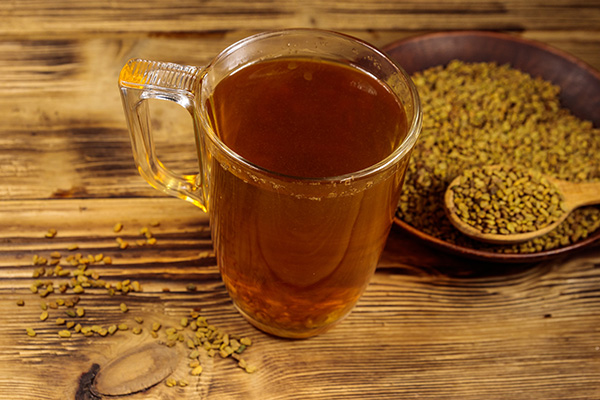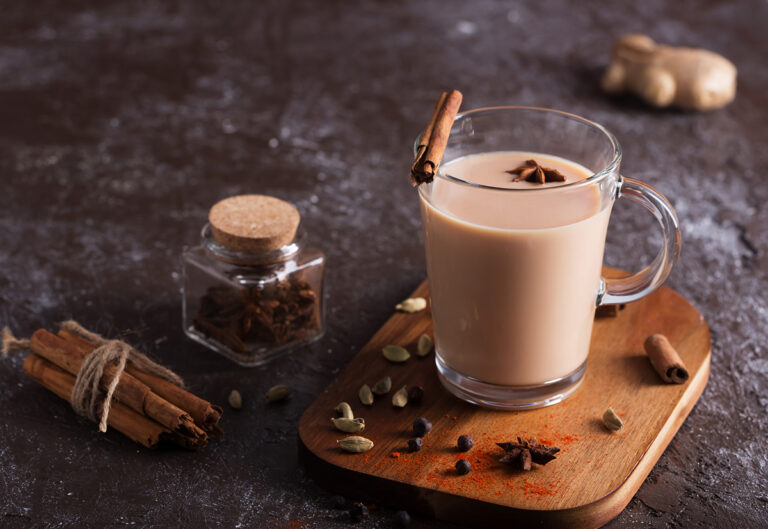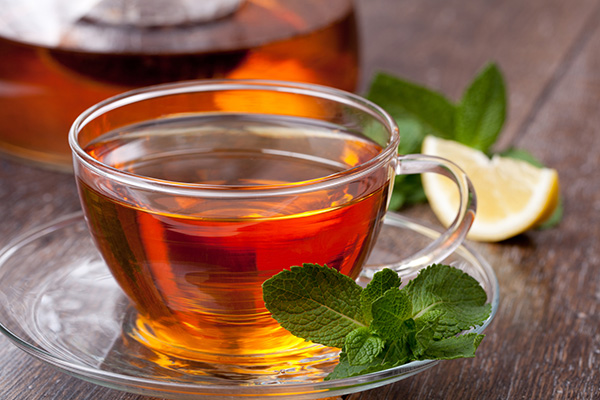The Best High Caffeine Teas: What Tea Has the Most Caffeine?
Are you a caffeine lover looking for a tea that packs a punch? Look no further! This article explores the best high-caffeine teas to give you the energy boost you need.

Which Tea Has the Most Caffeine?
Let’s dive into the world of high-caffeine teas to find out which one tops the list.
Black Tea
Black tea is the most well-known and widely consumed tea globally, known for its dark color and robust flavor. It is fully oxidized, which contributes to its rich taste and higher caffeine content compared to other tea types. Black tea contains around 40-70 milligrams of caffeine per 8-ounce cup, making it a popular choice for those looking for an energy boost.
Some popular black tea varieties include Assam, Darjeeling, Ceylon, and Earl Grey. Among these, Assam tea is considered the strongest.
Interested in trying black tea? Here are the best options available.

Yerba Mate
Yerba Mate is a traditional South American beverage made from the leaves of the Ilex paraguariensis plant, native to countries such as Argentina, Brazil, Paraguay, and Uruguay. It is not a true tea, as it doesn’t come from the Camellia sinensis plant. However, it is often consumed similarly to tea and shares some characteristics with it.
Yerba Mate has a unique earthy flavor with grassy and slightly bitter notes. It is known for its energizing properties and contains about 30-50 milligrams of caffeine per 8-ounce cup, making it a popular alternative to coffee.
Interested in trying yerba mate? Here are the best options available.
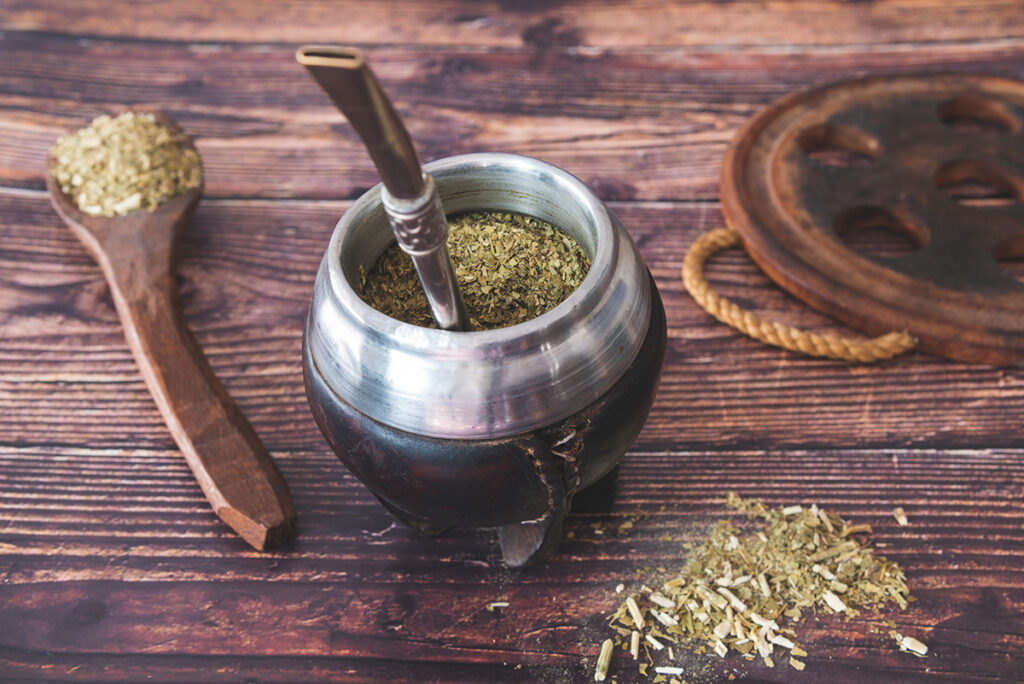
Pu-Erh Tea
Pu-Erh tea is a unique type of fermented Chinese tea originating from the Yunnan province. It is made from the leaves of the Camellia sinensis plant and is known for its earthy and mellow flavor, which can develop greater complexity over time.
There are two main types of Pu-Erh tea: raw (Sheng) and cooked (Shou). Raw Pu-Erh is naturally aged and fermented, while cooked Pu-Erh undergoes a faster, controlled fermentation process to mimic the aging process of raw Pu-Erh.
Pu-Erh tea has a caffeine content ranging from 30-70 milligrams per 8-ounce cup, depending on factors like the processing method, age, and steeping time.
It is often consumed for its potential health benefits, including aiding digestion and promoting weight loss.
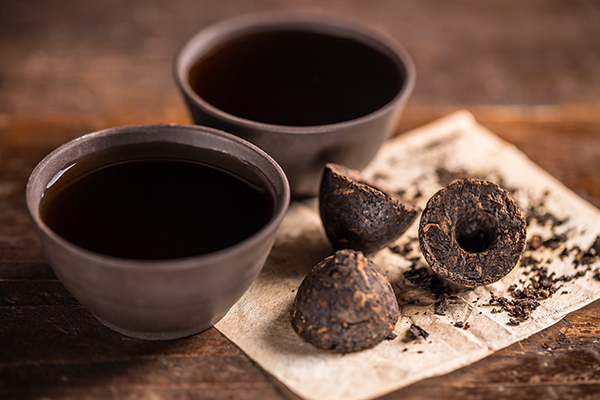
Matcha
Matcha is a unique form of green tea made from shade-grown tea leaves that are ground into a fine powder. The shading process increases the chlorophyll content in the leaves, resulting in a vibrant green color and higher levels of caffeine and antioxidants compared to other green teas.
Matcha is traditionally used in Japanese tea ceremonies and has become popular worldwide for its distinct flavor and health benefits.
A typical serving of matcha contains approximately 70 milligrams of caffeine per 8-ounce cup, making it a popular choice for those seeking an energy boost. The taste of matcha is characterized by its smooth, creamy texture and umami flavor with slightly sweet and vegetal notes.
Interested in trying matcha? Here are the best options available.
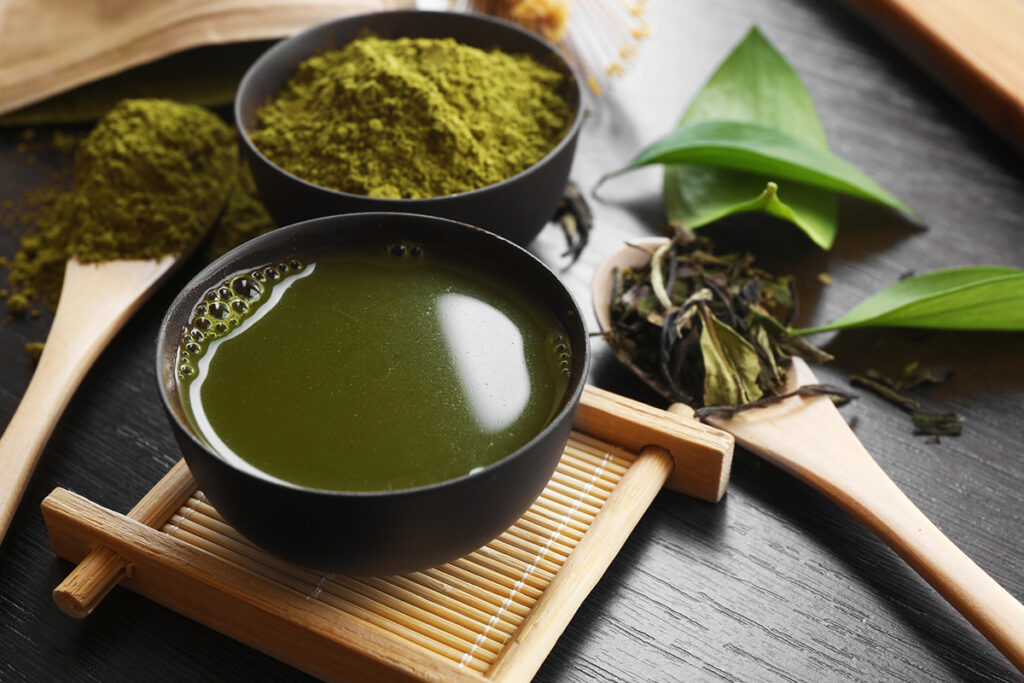
Shaded Green Teas
Shaded green teas, such as Gyokuro and Kabusecha, are unique Japanese green tea varieties grown under shaded conditions for a few weeks before harvesting. The shading process reduces the exposure of tea leaves to sunlight, which results in higher levels of chlorophyll, amino acids (especially L-theanine), and caffeine. This leads to a distinct flavor profile and enhanced health benefits compared to other green teas.
Shaded green teas are known for their rich umami flavor, with sweet, vegetal, and sometimes slightly savory notes. These teas contain about 35-50 milligrams of caffeine per 8-ounce cup, making them a suitable choice for those looking for a moderate caffeine boost without the jitters often associated with coffee.
What Factors Besides the Type of Tea Affect the Caffeine Content?
Several factors can influence the caffeine content of your tea.
Processing Method
The way tea is processed can impact its caffeine content. For instance, teas that undergo more oxidation, like black tea, generally have higher caffeine levels than less oxidized teas, like green or white tea.
Tea Cultivar
A tea cultivar refers to a specific variety of the tea plant, Camellia sinensis, which has been selectively bred for certain desirable characteristics such as flavor, aroma, and caffeine content. Tea cultivars can also be more suited to particular growing conditions or processing methods. The cultivar of a tea plant can significantly impact the final tea’s taste, appearance, and caffeine content.
There are two main species of Camellia sinensis used for tea production: Camellia sinensis var. sinensis and Camellia sinensis var. assamica. The former is native to China and better suited for making green, white, and lightly oxidized teas, while the latter is native to India and more suitable for producing dark, heavily oxidized teas like black tea and some pu-erh teas.
Different tea cultivars can have varying levels of caffeine. For instance, the Assamica variety typically has a higher caffeine content than the Camellia sinensis variety. Additionally, within each species, there are numerous sub-varieties or cultivars that can further influence the tea’s caffeine content, taste, and aroma. These sub-varieties are developed through selective breeding and can be specific to a particular region or tea-producing tradition.
Growing Conditions
Tea plants grown under shaded conditions or at higher elevations tend to have higher caffeine levels.
Harvesting and Plucking
The plucking standard and the age of the leaves also affect caffeine content. Younger leaves and buds usually have higher caffeine levels than older leaves.
Steeping Time
The length of time you steep your tea can affect its caffeine content. The longer you steep, the more caffeine is extracted.
Here’s a table with recommended steeping times for various teas:
| Tea Type | Steeping Time |
| Black | 3-5 minutes |
| Yerba Mate | 5-7 minutes |
| Pu-Erh | 3-5 minutes |
| Matcha | 1-2 minutes (whisked) |
| Green | 2-3 minutes |
| Oolong | 3-5 minutes |
| White | 2-3 minutes |
| Herbal | 5-7 minutes |
Water Temperature
Water temperature can also impact caffeine extraction. Higher water temperatures usually result in more caffeine being extracted.
Here’s a table with recommended water temperatures for various teas:
| Tea Type | Water Temperature |
| Black | 200-212°F (93-100°C) |
| Yerba Mate | 150-185°F (65-85°C) |
| Pu-Erh | 200-212°F (93-100°C) |
| Matcha | 160-175°F (70-80°C) |
| Green | 160-175°F (70-80°C) |
| Oolong | 185-205°F (85-96°C) |
| White | 160-185°F (70-85°C) |
| Herbal | 200-212°F (93-100°C) |
Tea-To-Water Ratio
The amount of tea you use per cup can affect the caffeine content. Using more tea leaves will result in a higher caffeine level.
Here’s a table with recommended amounts of loose-leaf tea for various teas:
| Tea Type | Amount per 8 oz (240 ml) of Water |
| Black | 1 teaspoon |
| Yerba Mate | 1 tablespoon |
| Pu-Erh | 1 teaspoon |
| Matcha | 1-2 teaspoons |
| Green | 1 teaspoon |
| Oolong | 1 teaspoon |
| White | 1-2 teaspoons |
| Herbal | 1 tablespoon |
Number of Infusions
Multiple infusions of the same tea leaves can result in varying caffeine levels. The first infusion typically has the highest caffeine content, with subsequent infusions having lower levels.
Final Thoughts
Tea can provide a wonderful and healthy source of caffeine for those looking for an energy boost. Experiment with different high-caffeine teas and brewing methods to find the perfect cup for your taste buds and energy needs.
FAQ
Is There Caffeine in Earl Grey Tea?
Yes, Earl Grey is a type of black tea and contains around 40-60 milligrams of caffeine per 8-ounce cup.
Is Tea Stronger the Longer You Steep It?
The longer you steep tea, the stronger its flavor and caffeine content will be. However, oversteeping can result in a bitter taste.
How Do You Get the Most Caffeine Out of Tea?
To maximize caffeine extraction, use a higher tea-to-water ratio, hotter water, and steep your tea for longer. However, try not to exceed the recommended water temperature and steeping time by much, as it may result in a bitter taste.
Is It Ok to Drink Strong Tea?
Drinking strong tea is generally safe, but excessive caffeine consumption can lead to side effects such as insomnia, jitters, or an upset stomach. It’s essential to know your personal caffeine tolerance and drink tea accordingly.
Is There Tea Stronger Than Coffee?
While most teas have less caffeine than coffee, some high-caffeine teas like matcha or Assam tea can come close to the caffeine content of a cup of coffee. However, this depends on the brewing method and the amount of tea used.
What Is the Best Tea to Replace Coffee With?
If you’re looking for a tea to replace coffee, try matcha, yerba mate, pu-erh, or black tea. These options have higher caffeine levels and can provide a similar energy boost without the jittery side effects of coffee.

